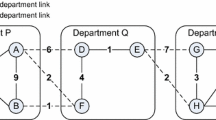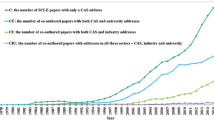Abstract
Interinstitutional scientific collaboration plays an important role in knowledge production and scientific development. Together with the increasing scale of scientific collaboration, a few institutions that positively participate in interinstitutional scientific collaboration are important in collaboration networks. However, whether becoming an important institution in collaboration networks could be a contributing factor to research success and how these important institutions collaborate are still indistinct. In this paper, we identified the scientific institutions that possess the highest degree centrality as important institutions of an interinstitutional scientific collaboration network in materials science and examined their collaboration preferences utilizing several network measures. We first visualized the appearance of these important institutions that had the most positive collaborations in the interinstitutional scientific collaboration networks during the period of 2005–2015 and found an obvious scale-free feature in interinstitutional scientific collaboration networks. Then, we measured the advantages of being important in collaboration networks to research performance and found that positive interinstitutional collaborations can always bring both publication advantages and citation advantages. Finally, we identified two collaboration preferences of these important institutions in collaboration networks—one type of important institution represented by the Chinese Academy of Science plays an intermediary role between domestic institutions and foreign institutions with high betweenness centrality and a low clustering coefficient. This type of important institution has better performance in the number of publications. The other type of important institution represented by MIT tends to collaborate with similar institutions that have positive collaborations and possess a larger citation growth rate. Our finding can provide a better understanding of important institutions’ collaboration preferences and have significant reference for government policy and institutional collaboration strategies.










Similar content being viewed by others
References
Abbasi, A., Altmann, J., & Hossain, L. (2011). Identifying the effects of co-authorship networks on the performance of scholars: a correlation and regression analysis of performance measures and social network analysis measures. TEMEP Discussion Papers, 5, 594–607.
Adams, J. (2012). Collaborations: The rise of research networks. Nature, 490, 335.
Asadi, S., Hussin, A. R. C., & Dahlan, H. M. (2017). Organizational research in the field of Green IT: A systematic literature review from 2007 to 2016. Telematics and Informatics, 34, 1191–1249.
Athen, M., Mondragón, R. J., & Vito, L. (2015). Anatomy of funded research in science. Proceedings of the National Academy of Sciences of the United States of America, 112, 14760.
Avkiran, N. K. (2013). An empirical investigation of the influence of collaboration in Finance on article impact. Scientometrics, 95, 911–925.
Barabasi, A. L., & Albert, R. (1999). Emergence of scaling in random networks. Science, 286, 509–512.
Barabási, A. L., Jeong, H., Néda, Z., Ravasz, E., Schubert, A., & Vicsek, T. (2001). Evolution of the social network of scientific collaborations. Physica A: Statistical Mechanics and its Applications, 311(3), 590–614.
Bhattacharyya, M., & Bandyopadhyay, S. (2015). Finding quasi core with simulated stacked neural networks. Information Sciences, 294, 1–14.
Bonacich, P., & Lloyd, P. (2001). Eigenvector-like measures of centrality for asymmetric relations. Social Networks, 23, 191–201.
Bornmann, L., & Daniel, H. D. (2005). Does the h-index for ranking of scientists really work? Scientometrics, 65, 391–392.
Breiger, R. L. (1974). The Duality of Persons and Groups. Social Forces, 53, 181–190.
Carrington, P. J., Scott, J., & Wasserman, S. (2005). Models and methods in social network analysis. Cambridge: Cambridge University Press.
Çavuşoğlu, A., & Türker, İ. (2014). Patterns of collaboration in four scientific disciplines of the Turkish collaboration network. Physica A: Statistical Mechanics and its Applications, 413, 220–229.
Chang, H. W., & Huang, M. H. (2013). Prominent institutions in international collaboration network in astronomy and astrophysics. New York: Springer.
Choi, S., Yang, S. W., & Han, W. P. (2015). The triple helix and international collaboration in science. Journal of the Association for Information Science and Technology, 66, 201–212.
Dorogovtsev, S. N., & Mendes, J. F. F. (2002). Evolution of networks. Advances in Physics, 51, 1079–1187.
Drożdż, S., Kulig, A., Kwapień, J., Niewiarowski, A., & Stanuszek, M. (2017). Hierarchical organization of H. Eugene Stanley scientific collaboration community in weighted network representation. Journal of Informetrics, 11, 1114–1127.
Ebadi, A., & Schiffauerova, A. (2015). How to become an important player in scientific collaboration networks? Journal of Informetrics, 9, 809–825.
Egghe, L., & Rousseau, R. (1990). Introduction to Informetrics. Information Processing and Management, 28, 1–3.
Fafchamps, M., Leij, M. J. V. D., & Goyal, S. (2010). Matching and network effects. Journal of the European Economic Association, 8, 203–231.
Freeman, L. C., Roeder, D., & Mulholland, R. R. (1980). Centrality in social networks: II. experimental result. Social Networks, 2, 119–141.
Fuchs, C. (2017). Sustainability and community networks. Telematics and Informatics, 34, 628–639.
Gazni, A., & Thelwall, M. (2016). The citation impact of collaboration between top institutions: A temporal analysis. Research Evaluation, 25, 219–229.
Ghosh, J., Kshitij, A., & Kadyan, S. (2015). Functional information characteristics of large-scale research collaboration: network measures and implications. Scientometrics, 102, 1207–1239.
Goh, K. I., Oh, E., Kahng, B., & Kim, D. (2003). Betweenness centrality correlation in social networks. Physical Review E: Statistical, Nonlinear, and Soft Matter Physics, 67, 017101.
Hirsch, J. E. (2005). An index to quantify an individual’s scientific research output. Proceedings of the National Academy of Sciences of the United States of America, 102, 16569–16572.
Hoekman, J., Frenken, K., & Tijssen, R. J. W. (2010). Research collaboration at a distance: Changing spatial patterns of scientific collaboration within Europe. Research Policy, 39, 662–673.
Karlovčec, M., & Mladenić, D. (2015). Interdisciplinarity of scientific fields and its evolution based on graph of project collaboration and co-authoring. Scientometrics, 102, 433–454.
Kockelmans, J. J. (Ed.). (1979). Interdisciplinarity and higher education. State College: The Pennysylvania State Univ.
Kronegger, L., Mali, F., Anu, X., Ferligoj, K., & Doreian, P. (2015). Classifying scientific disciplines in Slovenia: A study of the evolution of collaboration structures. Journal of the Association for Information Science and Technology, 66, 321–339.
Latora, V., Nicosia, V., & Panzarasa, P. (2013). Social cohesion, structural holes, and a tale of two measures. Journal of Statistical Physics, 151, 745–764.
Li, H. J., An, H. Z., Huang, J. C., Gao, X. Y., & Shi, Y. L. (2014). Correlation of the holding behaviour of the holding-based network of Chinese fund management companies based on the node topological characteristics. Acta Physica Sinica, 63, 048901–048913.
Li, J., & Li, Y. (2015). Patterns and evolution of coauthorship in China’s humanities and social sciences. Scientometrics, 102, 1997–2010.
Ma, A., & Mondragón, R. J. (2015). Rich-cores in networks. PLoS ONE, 10, e0119678.
Mattsson, P., Laget, P., Nilsson, A., & Sundberg, C. J. (2008). Intra-EU vs. extra-EU scientific co-publication patterns in EU. Scientometrics, 75, 555–574.
Mcpherson, J. M. (1982). Hypernetwork sampling: duality and differentiation among voluntary organizations ☆. Social Networks, 3, 225–249.
Melin, G., & Persson, O. (1996). Studying research collaboration using co-authorships. Scientometrics, 36, 363–377.
Moody, J. (2004). The structure of a social science collaboration network: Disciplinary cohesion from 1963 to 1999. American Sociological Review, 69, 213–238.
Newman, M. E. J. (2001). Scientific collaboration networks. I. Network construction and fundamental results. Physical Review E, 64, 016131.
Newman, M. E. (2003a). Mixing patterns in networks. Physical Review E: Statistical, Nonlinear, and Soft Matter Physics, 67, 026126.
Newman, M. E. J. (2003b). The structure and function of complex networks. SIAM Review, 45, 167–256.
Pike, T. W. (2010). Collaboration networks and scientific impact among behavioral ecologists. Behavioral Ecology, 21, 431–435.
Porter, A. L., & Youtie, J. (2009). How interdisciplinary is nanotechnology? Journal of Nanoparticle Research, 11, 1023–1041.
Raan, A. F. J. V. (2006). Comparison of the Hirsch-index with standard bibliometric indicators and with peer judgment for 147 chemistry research groups. Scientometrics, 67, 491–502.
Said, Y. H., Wegman, E. J., Sharabati, W. K., & Rigsby, J. T. (2008). RETRACTED: Social networks of author–coauthor relationships. Computational Statistics & Data Analysis, 52, 2177–2184.
Shahadat, U., Liaquat, H., & Kim, R. (2013). Network effects on scientific collaborations. PLoS ONE, 8, e57546.
Sigelman, L. (2009). Are two (or three or four…. or nine) heads better than one? Collaboration, multidisciplinarity, and publishability. PS Political Science and Politics, 42, 507–512.
Sonnenwald, D. H. (2014). Scientific collaboration. Annual Review of Information Science and Technology, 41, 643–681.
Taşkın, Z., & Aydinoglu, A. U. (2015). Collaborative interdisciplinary astrobiology research: a bibliometric study of the NASA Astrobiology Institute. Scientometrics, 103, 1003–1022.
Thijs, B., & Glänzel, W. (2010). A structural analysis of collaboration between European research institutes. Research Evaluation, 19, 55–65.
Wagner, C. S., Roessner, J. D., Bobb, K., Klein, J. T., Boyack, K. W., Keyton, J., et al. (2011). Approaches to understanding and measuring interdisciplinary scientific research (IDR): A review of the literature. Journal of Informetrics, 5, 14–26.
Wagner, C. S., Whetsell, T. A., & Leydesdorff, L. (2017). Growth of international collaboration in science: revisiting six specialties. Scientometrics, 110, 1633–1652.
Wallace, M. L., Larivière, V., & Gingras, Y. (2011). A small world of citations? The influence of collaboration networks on citation practices. PLoS ONE, 7, e33339.
White, J. C. (1992). Publication rates and trends in international collaborations for astronomers in developing countries, Eastern European countries, and the former Soviet Union. Publications of the Astronomical Society of the Pacific, 104, 472.
Wuchty, S., Jones, B. F., & Uzzi, B. (2007). The increasing dominance of teams in production of knowledge. Science, 316, 1036–1039.
Yan, E., & Ding, Y. (2012). Scholarly network similarities: How bibliographic coupling networks, citation networks, cocitation networks, topical networks, coauthorship networks, and coword networks relate to each other. Hoboken: Wiley.
Zhou, J., Zeng, A., Fan, Y., & Di, Z. (2018). Identifying important scholars via directed scientific collaboration networks. Scientometrics, 114, 1327–1343.
Acknowledgements
This research is supported by grants from the National Natural Science Foundation of China (Grant No. 41701121). The authors would like to express their gratitude to Prof. Haizhong An, Dr. Xiangyun Gao and Dr. Shupei Huang who provided valuable suggestions, and AJE-American Journal Experts who provided professional suggestions about language usage, spelling, and grammar.
Author information
Authors and Affiliations
Corresponding author
Rights and permissions
About this article
Cite this article
Li, Y., Li, H., Liu, N. et al. Important institutions of interinstitutional scientific collaboration networks in materials science. Scientometrics 117, 85–103 (2018). https://doi.org/10.1007/s11192-018-2837-0
Received:
Published:
Issue Date:
DOI: https://doi.org/10.1007/s11192-018-2837-0




